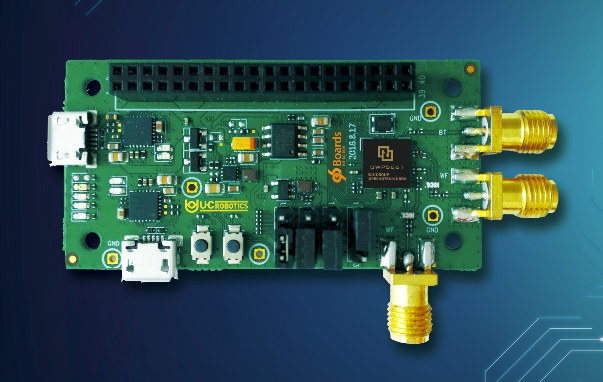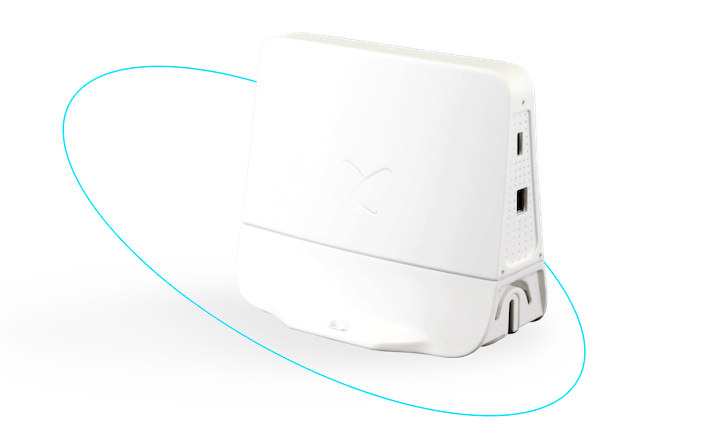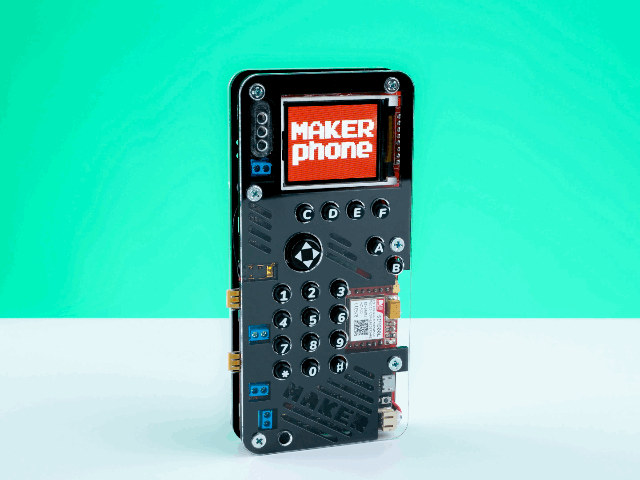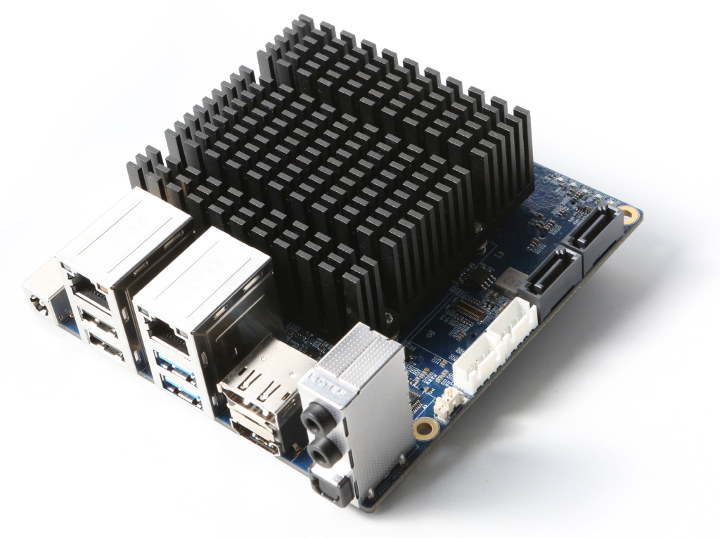Consumers don’t seem to be fans of bezels, so manufacturers try to keep them as small as possible, and many phones are now launched with a notch for the front-facing camera, and some with a front-facing camera that pops up during use. The former is not eye-pleasing to some users, and the latter may not feel robust. Nubia X smartphone does away with either simply because the company dropped the front-facing camera, instead relying on the rear camera plus a second screen on the back for selfies. This setup enables an utra-slim bezel on all four sides. Nubia X specifications: SoC – Snapdragon 845 octa-core processor with 4x Kryo 385 Gold cores @ up to 2.65 GHz, 4x Kryo 385 Silver cores @ up to 1.80 GHz, Adreno 630 GPU System Memory + Storage – 6GB LPDDR4X + 64GB storage, or 8GB LPDDR4X + 128 GB storage Displays 6.26″ main […]
96Boards IoT Edition IVY5661 Board Features UniSoC UWP5661 WiFi 5 + Bluetooth 5 SoC
If you ever wanted to start a new IoT project with WiFi and Bluetooth connectivity, you’d like think about using Espressif ESP32 WiSoC that supports single band 802.11 b/g/n WiFi (WiFi 4) and Bluetooth 4.2 LE thanks to great community and software support on top of the ultra low cost of the solution. But in case your require 802.11ac (WiFI 5) – yes, I’m trying hard to get used to the new WiFi naming scheme for consumers -, or Bluetooth 5, Espressif Systems does not offer such solution yet. Instead you may consider UniSoC UWP5661 Arm Cortex-M4 WiSoC with WiFi 5 & Bluetooth 5 connectivity that will be found in the soon-to-be-launched UcRobotics IVY5661 96Boards IoT Edition board. I could not find lots of information about UWP5661 chip tself, so let’s jump directly to IVY5661 board specifications: SoC – UniSoC UWP5661 dual core Arm Cortex-M4 microcontroller @ 416 MHz manufactured […]
Sigfox Introduces Access Station Micro Sigfox Gateway
There are plenty of long range LPWAN standards for the Internet of Things, but the most common ones include LoRaWAN, NB-IoT, and Sigfox. LoRaWAN lead the way in terms of deployments, while NB-IoT and eMTC leverage existing cellular infrastructure but cost a bit more to operate. Sigfox works with $2 modules, but AFAIK so far you had to subscribe to the company network, and if your area was not covered you were out of luck. Sigfox Access Station Micro gateway promises to change the situation, as companies can now add their own Sigfox gateway(s) where coverage is not available, and this could make Sigfox more popular, especially if one or more communities similar to The Things Networks form(s) around it. Sigfox Access Station Micro SMBS-T4 specifications: Radio characteristics: Standard – Sigfox Ultra Narrow Band Protocol for M2M and IoT Max range of operating frequencies – 865 to 928 MHz Max […]
$94 MAKERphone DIY Mobile Phone Supports MicroPython, Arduino IDE, and Scratch (Crowdfunding)
If you ever wanted to buy a mobile phone that you can assemble yourself, RePhone Kit Ctreate going for $59 is a nice option, but in truth it does not exactly look like your typical phone with its almost square shape. It’s also good to have more option, that’s exactly what MAKERphone is offering with a DIY mobile phone targeting the educational market. Beside the educational value of the assembly also involving some soldering skills depending on the selected kit, kids will be able to learn to program the phone with MicroPython, the Arduino IDE (C language), and/or Scratch visual programming. MAKERphone kit content and specifications: MAKERphone circuit board with 8x user LEDs for backlight (and special effects), 4-way mechanical joystick, 12-button numeric keypad, A, B, C, D, E, and F buttons, DS3231 RTC chip, vibrator… Main microcomputer module based on Espressif Systems ESP32 WiSoC with 802.11 b/g/n WiFi, Bluetooth […]
Embedded Recipes 2018 Videos and Slides Released
Embedded Recipes 2018 happened in Mozilla building in Paris, France on September 24 & 25, where developers talked about “open source solutions in the embedded world: developer, contributor, tools, platforms…” We previously mentioned the event in a post about an open source video decoder driver for Amlogic S905, S905X and S912 processors with BayLibre scheduled to talk about their work there. There’s now released slides and videos for the event for all sessions including: SoC+FPGA support in 2018 by Marek Vasut Shared memory and telemetry by Yves-Marie Morgan Updating an embedded system with swupdate by Charles-Antoine Couret Finding sources of latency in your system by Steven Rostedt Io(M)T Security: A year in review by Rayna Stamboliyska Using yocto to generate container images for yocto by Jérémy Rosen linuxboot by Jean-Marie Verdun and Trammell Hudson End-to-end software production for embedded by Guy Lunardi WooKey: the USB Battlefront Warrior by Mathieu Renard, […]
Sipeed M1 RISC-V Computer Vision Module Features Kendryte K210 Processor
Just a few days ago, I wrote about Kendryte KD233 board featuring Kendryte K210 dual core RISC-V processor, with some fairly detailed documentation, public links to toolchains and other tools. and going for $50. But the team behind LicheePi boards informed me that they also made their own K210 module called Sipeed M1 and selling on Taobao for the Chinese market, as well as on Yoycart for $10.89 plus shipping for the oversea market, and you’ll find a devkit with a dock board for about $24 and up depending on options. Sipeed M1 module specifications: SoC – Kendryte K210 dual core 64-bit RISC-V processor @ 400 MHz with KPU CNN hardware accelerator, APU audio hardware accelerator, 6 MB general purpose SRAM, 2MB AI SRAM memory, and AXI ROM to load user program from SPI flash Package – 72-pin (25.4 x 25.4mm) But you’ll probably want to get start with M1 […]
Geniatech XPI-S905X Board Leverages Raspberry Pi 3 Form Factor
Geniatech is well known in the media player industry for their Amlogic based TV boxes, but in recent years, they’ve also launched some development board from other silicon vendors such as Qualcomm with Developer Board IV and Developer Board 8 powered by respectively Snapdragon 410E and 820E. The company has now launched the XPI family of single board computers that will allow closely follow Raspberry Pi 3 form factor while offering better performance and features. Geniatech will start with XPI-S905X board powered by an Amlogic S905X quad core Cortex A53 processor @ 1.5 GHz with 4K HDR video playback and output capability. Geniatech XPI-S905X board preliminary specifications: SoC – Amlogic S905X quad core ARM Cortex-A53 processor @ up to 1.5 GHz (but they claim 1.6 to 2.0 GHz max…) with penta core ARM Mali-450MP GPU, and Amlogic Video Engine 10 System Memory – 1GB or 2GB (default) DDR3 RAM Storage […]
ODROID-H2 Intel Celeron J4105 Single Board Computer to Launch in November
There were talks about Hardkernel working on an ODROID x86 board since last year, as the CEO expected to launch such board later in 2017 in an interview published in ODROID magazine. Finally, it took them several iterations and processors considerations before being ready for launch, and ODROID-H2 should become available next month as the first ODROID x86 board. ODROID-H2 will feature an Intel Celeron J4105 Gemini Lake processor, two SO-DIMM slots for memory, two SATA ports and M.2 NVMe slot for storage, two Gigabit Ethernet ports, a mix of USB 3.0 and 2.0 ports, and more. ODROID-H2 board specifications: SoC – Intel Celeron J4105 quad core processor @ up to 2.3 GHz (real frequency) with 12EU Intel UHD Graphics 600 System Memory – Dual-channel Memory DDR4-PC19200 (2400MT/s) supporting up to 32GiB RAM in total Storage – M.2 PCIe 2.0 x4 slot for one NVMe storage, 2x SATA 3.0 ports, […]










